Summer Research Experience for Undergraduates
 Pages from 2016 CEM Research for Undergraduates Journal Part 1
Pages from 2016 CEM Research for Undergraduates Journal Part 2
Pages from 2016 CEM Research for Undergraduates Journal Part 3
Pages from 2016 CEM Research for Undergraduates Journal Part 1
Pages from 2016 CEM Research for Undergraduates Journal Part 2
Pages from 2016 CEM Research for Undergraduates Journal Part 3
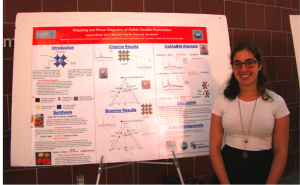 Name: Liana Alves
Undergraduate Institution: Haverford College
Major: Chemistry
REU Advisor: Dr. Pat Woodward
Project Title: Mapping out Phase Diagrams of Halide Double Perovskites
Abstract:
The synthesis of the double perovskites Cs2AgBiCl6, Cs2AgInCl6, Cs2NaInCl6 from solutionmethods have been analyzed using x-ray diffractions. In order to understand what byproducts arebeing made in the complex synthesis of the double perovskites, multiple ternary phase diagramshave been constructed with each point representing a compound synthesized by either solutionor solid state grinding methods. The ternary phase diagrams vary by halide X=Cl, Br, I and by theM3+ =Bi, Sb, In site with the constant AgX and CsX component. The phase diagrams help organizethe synthesis data for any future research done on lead free halide double perovskites. Multiplesynthesis attempts were made on the Cs2AgBiI6 using different reagents and solvents, but theXRD is not conclusive to declare the perovskite form. The Cl-Bi and Br-Bi are complete phasediagrams, but the I-Bi diagram products indicate the system is not yet thermodynamically stable.Synthesis of AgBiBr4, Cs3BiBr6, AgBi2I7 have no literature cited crystal structure and their x-raycrystallography images show promise for solving their structures.
Name: Liana Alves
Undergraduate Institution: Haverford College
Major: Chemistry
REU Advisor: Dr. Pat Woodward
Project Title: Mapping out Phase Diagrams of Halide Double Perovskites
Abstract:
The synthesis of the double perovskites Cs2AgBiCl6, Cs2AgInCl6, Cs2NaInCl6 from solutionmethods have been analyzed using x-ray diffractions. In order to understand what byproducts arebeing made in the complex synthesis of the double perovskites, multiple ternary phase diagramshave been constructed with each point representing a compound synthesized by either solutionor solid state grinding methods. The ternary phase diagrams vary by halide X=Cl, Br, I and by theM3+ =Bi, Sb, In site with the constant AgX and CsX component. The phase diagrams help organizethe synthesis data for any future research done on lead free halide double perovskites. Multiplesynthesis attempts were made on the Cs2AgBiI6 using different reagents and solvents, but theXRD is not conclusive to declare the perovskite form. The Cl-Bi and Br-Bi are complete phasediagrams, but the I-Bi diagram products indicate the system is not yet thermodynamically stable.Synthesis of AgBiBr4, Cs3BiBr6, AgBi2I7 have no literature cited crystal structure and their x-raycrystallography images show promise for solving their structures.
Name: Jordan Fuhrman Pages from 2016 CEM Research for Undergraduates Journal Part 1
Pages from 2016 CEM Research for Undergraduates Journal Part 2
Pages from 2016 CEM Research for Undergraduates Journal Part 3
Pages from 2016 CEM Research for Undergraduates Journal Part 1
Pages from 2016 CEM Research for Undergraduates Journal Part 2
Pages from 2016 CEM Research for Undergraduates Journal Part 3
2016 Summer REU Student Information & Research Abstracts
 Name: Liana Alves
Undergraduate Institution: Haverford College
Major: Chemistry
REU Advisor: Dr. Pat Woodward
Project Title: Mapping out Phase Diagrams of Halide Double Perovskites
Abstract:
The synthesis of the double perovskites Cs2AgBiCl6, Cs2AgInCl6, Cs2NaInCl6 from solutionmethods have been analyzed using x-ray diffractions. In order to understand what byproducts arebeing made in the complex synthesis of the double perovskites, multiple ternary phase diagramshave been constructed with each point representing a compound synthesized by either solutionor solid state grinding methods. The ternary phase diagrams vary by halide X=Cl, Br, I and by theM3+ =Bi, Sb, In site with the constant AgX and CsX component. The phase diagrams help organizethe synthesis data for any future research done on lead free halide double perovskites. Multiplesynthesis attempts were made on the Cs2AgBiI6 using different reagents and solvents, but theXRD is not conclusive to declare the perovskite form. The Cl-Bi and Br-Bi are complete phasediagrams, but the I-Bi diagram products indicate the system is not yet thermodynamically stable.Synthesis of AgBiBr4, Cs3BiBr6, AgBi2I7 have no literature cited crystal structure and their x-raycrystallography images show promise for solving their structures.
Name: Liana Alves
Undergraduate Institution: Haverford College
Major: Chemistry
REU Advisor: Dr. Pat Woodward
Project Title: Mapping out Phase Diagrams of Halide Double Perovskites
Abstract:
The synthesis of the double perovskites Cs2AgBiCl6, Cs2AgInCl6, Cs2NaInCl6 from solutionmethods have been analyzed using x-ray diffractions. In order to understand what byproducts arebeing made in the complex synthesis of the double perovskites, multiple ternary phase diagramshave been constructed with each point representing a compound synthesized by either solutionor solid state grinding methods. The ternary phase diagrams vary by halide X=Cl, Br, I and by theM3+ =Bi, Sb, In site with the constant AgX and CsX component. The phase diagrams help organizethe synthesis data for any future research done on lead free halide double perovskites. Multiplesynthesis attempts were made on the Cs2AgBiI6 using different reagents and solvents, but theXRD is not conclusive to declare the perovskite form. The Cl-Bi and Br-Bi are complete phasediagrams, but the I-Bi diagram products indicate the system is not yet thermodynamically stable.Synthesis of AgBiBr4, Cs3BiBr6, AgBi2I7 have no literature cited crystal structure and their x-raycrystallography images show promise for solving their structures.
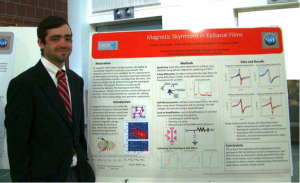 Undergraduate Institution: University of Alabama
Major: Physics and Mathematics
REU Advisor: Dr. Fengyuan Yang
Project Title: Magnetic Skyrmions in Epitaxial Films
Abstract:
In magnetic information storage systems, the ability to manipulate magnetic structures is paramount. The skyrmion, a vortex of spins, is one candidate for the improvement of information processing1-3. Skyrmions have been observed in someB20 phase crystals, including FeGe, due to the non-symmetric structure of the B20lattice. Additionally, FeGe thin films have a larger skyrmion phase range than their bulk FeGe crystal counterparts1. This skyrmion phase can be detected through the topological Hall effect. Previous studies have shown that the current density must exceed a critical value in order to cause depinning, or motion, of the skyrmion 4. This project focuses on analyzing the relationship between the topological Hall effect,critical current density for skyrmion motion, and the thickness of the films. The FeGe films are produced using off-axis magnetron sputtering, and are then characterized using both X-ray diffraction and Hall measurements. In order to observe this phenomenon at low current densities, this project employs the use of lock-in technique to achieve increased sensitivity of the topological Hall measurements.These measurements could be valuable for utilizing FeGe thin films in low energy cost spintronic applications.
Undergraduate Institution: University of Alabama
Major: Physics and Mathematics
REU Advisor: Dr. Fengyuan Yang
Project Title: Magnetic Skyrmions in Epitaxial Films
Abstract:
In magnetic information storage systems, the ability to manipulate magnetic structures is paramount. The skyrmion, a vortex of spins, is one candidate for the improvement of information processing1-3. Skyrmions have been observed in someB20 phase crystals, including FeGe, due to the non-symmetric structure of the B20lattice. Additionally, FeGe thin films have a larger skyrmion phase range than their bulk FeGe crystal counterparts1. This skyrmion phase can be detected through the topological Hall effect. Previous studies have shown that the current density must exceed a critical value in order to cause depinning, or motion, of the skyrmion 4. This project focuses on analyzing the relationship between the topological Hall effect,critical current density for skyrmion motion, and the thickness of the films. The FeGe films are produced using off-axis magnetron sputtering, and are then characterized using both X-ray diffraction and Hall measurements. In order to observe this phenomenon at low current densities, this project employs the use of lock-in technique to achieve increased sensitivity of the topological Hall measurements.These measurements could be valuable for utilizing FeGe thin films in low energy cost spintronic applications.
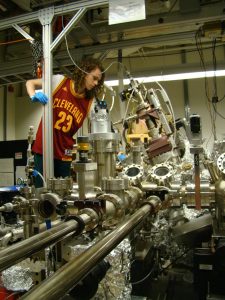 Name: Adam Goad
Undergraduate Institution: University of Maryland, Baltimore County
Major: Physics and Mathematics
REU Advisor: Dr. Roland Kawakami
Project Title: Proximity Induced Ferromagnetism in Pt|CoFe2O4 Hybrid Interfaces
Abstract:
Manipulation of electron spin is essential to unlocking the potential of spin-based logic devices for information processing. Inducing magnetism within nonmagnetic materials by means of a proximity effect will enable us to more definitively and effectively manipulate electron spin within a system. With our project, we are looking to report evidence of proximity induced ferromagnetism in a thin film of Pt covering a ferromagnetic insulator, CoFe2O4. Hall bars are created to enable us to make Hall measurement of the induced ferromagnetic Pt thin film. If an anomalous hall effect is present in the Pt thin film, evident of proximity induced ferromagnetism, then we will see a non-linear relationship between the measured Hall voltage and the applied magnetic field. When we have confirmed the presence of proximity induced ferromagnetism in a nonmagnetic thin film, we can attempt to tune the effect. By taking Hall measurements of Hall bars with different termination layers, we may be able to control the presence and even magnitude of our observed induced magnetism. If we can verify proximity induced ferromagnetism in thin films, then we can pursue verification of proximity induced ferromagnetism in two-dimensional (2D)materials. The possibilities of 2D materials are bountiful, but if we are able to exhibit proximity induced ferromagnetism in them, we can unlock the possibilities of 2D materials that are limited by non-magnetism.
Name: Adam Goad
Undergraduate Institution: University of Maryland, Baltimore County
Major: Physics and Mathematics
REU Advisor: Dr. Roland Kawakami
Project Title: Proximity Induced Ferromagnetism in Pt|CoFe2O4 Hybrid Interfaces
Abstract:
Manipulation of electron spin is essential to unlocking the potential of spin-based logic devices for information processing. Inducing magnetism within nonmagnetic materials by means of a proximity effect will enable us to more definitively and effectively manipulate electron spin within a system. With our project, we are looking to report evidence of proximity induced ferromagnetism in a thin film of Pt covering a ferromagnetic insulator, CoFe2O4. Hall bars are created to enable us to make Hall measurement of the induced ferromagnetic Pt thin film. If an anomalous hall effect is present in the Pt thin film, evident of proximity induced ferromagnetism, then we will see a non-linear relationship between the measured Hall voltage and the applied magnetic field. When we have confirmed the presence of proximity induced ferromagnetism in a nonmagnetic thin film, we can attempt to tune the effect. By taking Hall measurements of Hall bars with different termination layers, we may be able to control the presence and even magnitude of our observed induced magnetism. If we can verify proximity induced ferromagnetism in thin films, then we can pursue verification of proximity induced ferromagnetism in two-dimensional (2D)materials. The possibilities of 2D materials are bountiful, but if we are able to exhibit proximity induced ferromagnetism in them, we can unlock the possibilities of 2D materials that are limited by non-magnetism.
 Name: Patricio Herrera
Undergraduate Institution: New Mexico Highlands University
Major: Civil Engineering
REU Advisor: Dr. Denis Pelekhov
Project Title: The Development of a Simulation model for calculating the MagneticField of a Complex Ferromagnetic Structure
Abstract:
The research done this summer was to solve the calculation of the magnetic field of a complex ferromagnetic structure. The method used was a “Coulombian approach”. This technique uses an equivalent distribution of point charges that are within the structure and surface.The process is done by integrating small charged values distance‘d’ away from a point of interest.This was implemented numerically with the MatLab package. A great part of this program is the fact that I could do complex structures, which broadens its uses. The simulation is also designed todo the calculation more rapidly using numerical integration by means of MatLab and C. The code is designed to be user friendly to assist the local collaboration by comparing their experiments to the theory. For example, this code will be compared to Yttrium Iron Garnet (YIG) which is a very desirable material, because of its microwave properties.
Name: Patricio Herrera
Undergraduate Institution: New Mexico Highlands University
Major: Civil Engineering
REU Advisor: Dr. Denis Pelekhov
Project Title: The Development of a Simulation model for calculating the MagneticField of a Complex Ferromagnetic Structure
Abstract:
The research done this summer was to solve the calculation of the magnetic field of a complex ferromagnetic structure. The method used was a “Coulombian approach”. This technique uses an equivalent distribution of point charges that are within the structure and surface.The process is done by integrating small charged values distance‘d’ away from a point of interest.This was implemented numerically with the MatLab package. A great part of this program is the fact that I could do complex structures, which broadens its uses. The simulation is also designed todo the calculation more rapidly using numerical integration by means of MatLab and C. The code is designed to be user friendly to assist the local collaboration by comparing their experiments to the theory. For example, this code will be compared to Yttrium Iron Garnet (YIG) which is a very desirable material, because of its microwave properties.
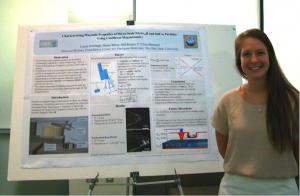 Name: Laura Jennings
Undergraduate Institution: Wake Forest University
Major: Physics and Mathematical Business
REU Advisor: Dr. Chris Hammel
Project Title: Characterizing Magnetic Properties of Micro-Scale Nd2Fe14B and SmCo5Particles Using Cantilever Magnetometry
Abstract:
On a microscopic scale, the properties of Samarium Cobalt (SmCo5) and Neodymium IronBoron (Nd2Fe14B) behave differently than in bulk measurements. With the use of a cantilever, the small signals of these magnets can be measured in order to characterize the particles. Through cantilever magnetometry, when sweeping an applied external field, aFrequency vs. Field graph can be constructed that allows for the measurement of moment and coercive field. The moment of a 5.4-micron diameter samarium cobalt particle was measured to be 3.1 × 10−9. For another Samarium Cobalt sample, the moment was measured to be 1.0351 × 10−9 with a coercive field of 17587 G. Through this experiment, these results were evaluated and future directions were advised.
Name: Laura Jennings
Undergraduate Institution: Wake Forest University
Major: Physics and Mathematical Business
REU Advisor: Dr. Chris Hammel
Project Title: Characterizing Magnetic Properties of Micro-Scale Nd2Fe14B and SmCo5Particles Using Cantilever Magnetometry
Abstract:
On a microscopic scale, the properties of Samarium Cobalt (SmCo5) and Neodymium IronBoron (Nd2Fe14B) behave differently than in bulk measurements. With the use of a cantilever, the small signals of these magnets can be measured in order to characterize the particles. Through cantilever magnetometry, when sweeping an applied external field, aFrequency vs. Field graph can be constructed that allows for the measurement of moment and coercive field. The moment of a 5.4-micron diameter samarium cobalt particle was measured to be 3.1 × 10−9. For another Samarium Cobalt sample, the moment was measured to be 1.0351 × 10−9 with a coercive field of 17587 G. Through this experiment, these results were evaluated and future directions were advised.
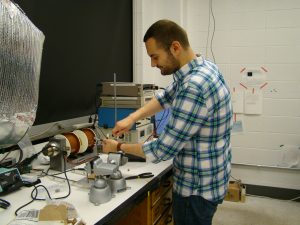 Name: Jason Marquez
Undergraduate Institution: New Mexico Highlands University
Major: Engineering and Mathematics
REU Advisor: Dr. Roberto Myers
Project Title: Anomalous Nernst Effect and Magnetization in GaFe Wire
Abstract:
Thermal gradient exploitation via ambient differences is essential in plumbing pipes, engine exhaust systems, and possibly cold refrigerant housings. With the Nerst Effect (NE) and Anomalous Nerst Effect (ANE), temperature differences can be utilized to harvest electricity. This study focused on the thermal-electric material Galfenol (GaFe) because of its predicted large ANE coefficient. It was found that the voltage does exactly track along magnetization, which implies that GaFe exhibits both NE and ANE properties. GaFe was also discovered to have a hard axis along the magnetic field direction. This resulted in the NE quickly overpowering ANE during the measurement.
Name: Jason Marquez
Undergraduate Institution: New Mexico Highlands University
Major: Engineering and Mathematics
REU Advisor: Dr. Roberto Myers
Project Title: Anomalous Nernst Effect and Magnetization in GaFe Wire
Abstract:
Thermal gradient exploitation via ambient differences is essential in plumbing pipes, engine exhaust systems, and possibly cold refrigerant housings. With the Nerst Effect (NE) and Anomalous Nerst Effect (ANE), temperature differences can be utilized to harvest electricity. This study focused on the thermal-electric material Galfenol (GaFe) because of its predicted large ANE coefficient. It was found that the voltage does exactly track along magnetization, which implies that GaFe exhibits both NE and ANE properties. GaFe was also discovered to have a hard axis along the magnetic field direction. This resulted in the NE quickly overpowering ANE during the measurement.
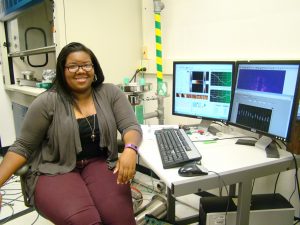 Name: Maranda Reed
Undergraduate Institution: The Ohio State University
Major: Electrical Engineering
REU Advisor: Dr. Leonard Brillson
Project Title: Surface Photovoltage Spectroscopy of a Dual Polarity Two-DimensionalSemiconductor
Abstract:
This investigation is focused on the study of 2D Methyl-Terminated Germanane electronic properties as it pertains to defect detection and characterization. The study of germanane is of interest because it is a 2D direct bandgap semiconductor which has applications in optoelectronics. GeCH3 was found to have a possible duality in conduction response when put under testing using surface photovoltage spectroscopy. The implications of this finding can impact material synthesis.
Name: Maranda Reed
Undergraduate Institution: The Ohio State University
Major: Electrical Engineering
REU Advisor: Dr. Leonard Brillson
Project Title: Surface Photovoltage Spectroscopy of a Dual Polarity Two-DimensionalSemiconductor
Abstract:
This investigation is focused on the study of 2D Methyl-Terminated Germanane electronic properties as it pertains to defect detection and characterization. The study of germanane is of interest because it is a 2D direct bandgap semiconductor which has applications in optoelectronics. GeCH3 was found to have a possible duality in conduction response when put under testing using surface photovoltage spectroscopy. The implications of this finding can impact material synthesis.
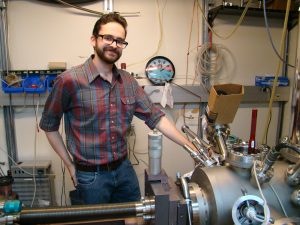 Name: Ryan Rodriguez
Undergraduate Institution: Lawrence Technological University
Major: Physics
REU Advisor: Dr. Jay Gupta
Project Title: Gate Dependent Transport and Scanning Tunneling Microscopy of a Graphene Device
Abstract:
Graphene, recognized as a two dimensional (2D) hexagonal lattice of carbon atoms,presents interesting electrical properties that show potential in electrical applications. The goal of this research is to provide characterization data for 1 micron wide gated graphene sheet and the scanning tunneling microscopy/spectroscopy (STM/STS) investigation of the electron transport for cobalt coated graphene devices. Graphene will be analyzed using atomically resolved scanning tunneling microscopy while a back gate voltage is applied to shift the Fermi level. The resistance of uncoated graphene will be measured with respect to the back gate voltage applied. We provide a method for navigate to small (< 10 micron) wide graphene via capacitance navigation as well as transport data for graphene at ultra-high vacuum pressures.
Name: Ryan Rodriguez
Undergraduate Institution: Lawrence Technological University
Major: Physics
REU Advisor: Dr. Jay Gupta
Project Title: Gate Dependent Transport and Scanning Tunneling Microscopy of a Graphene Device
Abstract:
Graphene, recognized as a two dimensional (2D) hexagonal lattice of carbon atoms,presents interesting electrical properties that show potential in electrical applications. The goal of this research is to provide characterization data for 1 micron wide gated graphene sheet and the scanning tunneling microscopy/spectroscopy (STM/STS) investigation of the electron transport for cobalt coated graphene devices. Graphene will be analyzed using atomically resolved scanning tunneling microscopy while a back gate voltage is applied to shift the Fermi level. The resistance of uncoated graphene will be measured with respect to the back gate voltage applied. We provide a method for navigate to small (< 10 micron) wide graphene via capacitance navigation as well as transport data for graphene at ultra-high vacuum pressures.
